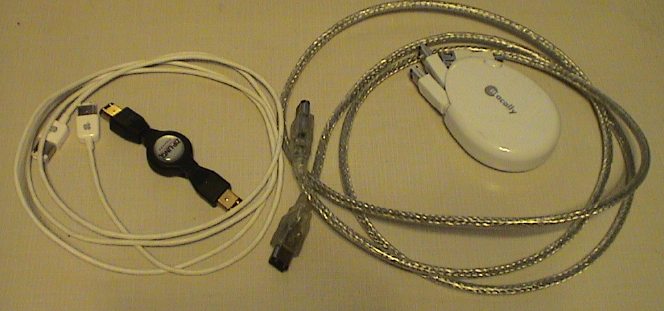FireWire Tips
[ Previous Tip ] [
Mac Tips ] [ Next Tip
]
FireWire is Apple's name for a high speed serial link. Apple
developed this protocol for connecting serial devices. The speed of
this link is either 400 MBits/sec (FireWire 400) or 800 MBits/sec
(FireWire 800). The protocol is also known as IEEE-1394. Sony calls it
iLink. More generically, FireWire is an implementation of LVDS (Low Voltage Differential Signaling). The signal paths are current loops with a characteristic impedance of 100 ohms and a signaling current of about 3.5 mA. This produces a 350 mV differential signal that is very good for high speed transfers over short distances. FireWire 800 is actually the same system, just with a better connector and higher clock speeds.
Firewire is generally considered to be technically superior to USB
2.0 but it is not nearly as common. USB 2.0 has a peak data rate of 480
MBits/sec for short bursts but it typically cannot sustain that rate
continously. This is demonstrated by some test data below. FireWire
generally provides better performance for applications that require
high sustained rates such as the connection of external disks. However,
FireWire uses dedicated hardware to manage the connection so that it
tends to cost more, therefore it is used less than USB 2.0.
The reason for this page is that I got a retractable FireWire cable
for Christmas and when I used it, I noticed that maybe this particular
cable didn't work so well. Therefore I tested it and 3 other cables. I
found that all "FireWire" cables are indeed not the same.
 I have 4 FireWire cables. The small black one in
the left is a Zip-Linq 6
pin retractable cable, the white one surrounding it is a standard
Apple 6 pin cable. The white egg shaped thing is a Macally
rectractable cable and the silver one surrounding that is a Belkin
cable. The black Zip-Linq cable was the apparent bad actor.
I have 4 FireWire cables. The small black one in
the left is a Zip-Linq 6
pin retractable cable, the white one surrounding it is a standard
Apple 6 pin cable. The white egg shaped thing is a Macally
rectractable cable and the silver one surrounding that is a Belkin
cable. The black Zip-Linq cable was the apparent bad actor.
The test involved a 485 Mbyte file transfer through each of the 4
cables from an iMac Core Duo to a PowerBook G4 and to an OWC Neptune
external 160 MByte disk. Both the iMac and Neptune disks are 7200 RPM,
the PowerBook was run in target disk mode and has a 4200 RPM disk.
The test data came out like this, 3 of the cables were essentially
identical in performance with the speeds limited by the speeds of the
disks involved. The other was clearly different.
FireWire Cable Performance Test
| Cable |
Data Rate (Mbytes/sec) |
| iMac to PB |
iMac to Neptune |
| Zip-Linq |
8.5 |
write errors |
| Apple |
9.5 |
32.5 |
| Macally |
9.5 |
32.5 |
| Belkin |
9.5 |
32.5 |
During the test where the data rate was limited by the slow disk in
the PowerBook, the Zip-Linq cable worked, but not well. When the data
rate was high, the Zip-Linq cable just folded up and died.
By the way, the Macally retractable cable comes with 6 pin
connectors at each end and a 6 pin to 4 pin adaptor (barely visible in
the photo). I found another 6 pin to 4 pin adaptor at Fry's so that I
can use any of these cables with the two adaptors to connect a
Sony DV camcorder to a DVD recorder deck (with a 4 pin DV input). This
approach is actually less expensive than buying a dedicated 4 pin to 4
pin cable.
FireWire Vs. USB
I have 3 external disks, all 7200 rpm. One is the Firewire only 160 GB Neptune
drive. Another is a 250 GB LaCie USB only drive. A third is a 750 GB
Seagate drive that has both USB and FireWire 400 interfaces. It is
pretty clear that USB 2.0 can't hold a candle to FireWire 400 even
though USB is rated as a "faster" interface.
I tested each disk on a iMac Core Duo with an internal 7200 rpm drive by copying a ~500 MB file and reading the speed on the Activitiy Monitor.
FireWire Vs. USB Disk Speeds
| Manufacturer |
Model |
Size (GB) |
Disk Speed (rpm) |
Interface |
Data Rate (MB/sec) |
| OtherWorld Computing |
Neptune |
160 |
7200 |
FireWire 400 |
32.5 |
| LaCie |
Porche Design |
250 |
7200 |
USB 2.0 |
17 |
| Seagate |
FreeAgent Pro |
750 |
7200 |
FireWire 400 |
31.5 |
| USB 2.0 |
16 |
[ Previous Tip ] [
Mac Tips ] [ Next Tip
]
This page has been accessed  times since 25 Dec 06
times since 25 Dec 06
© 2006-2007 George Schreyer
Created 25 Dec 06
Last Updated August 12, 2007
 I have 4 FireWire cables. The small black one in
the left is a Zip-Linq 6
pin retractable cable, the white one surrounding it is a standard
Apple 6 pin cable. The white egg shaped thing is a Macally
rectractable cable and the silver one surrounding that is a Belkin
cable. The black Zip-Linq cable was the apparent bad actor.
I have 4 FireWire cables. The small black one in
the left is a Zip-Linq 6
pin retractable cable, the white one surrounding it is a standard
Apple 6 pin cable. The white egg shaped thing is a Macally
rectractable cable and the silver one surrounding that is a Belkin
cable. The black Zip-Linq cable was the apparent bad actor.